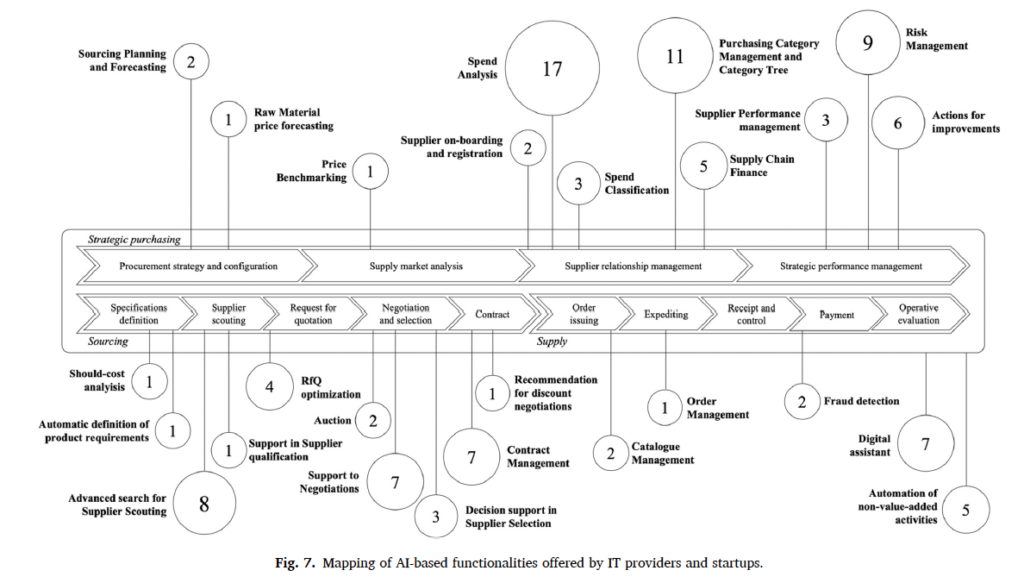In this series, we discuss AI’s impact on procurement. We’ve unpacked GenAI in Part 1 and delved into the predictive power of Machine Learning in reshaping procurement strategies and decision-making in Part 2.
In the final instalment, we pivot towards the negotiation arena, introducing Haggle Bots and discussing the broader cases of AI uses across the end-to-end procurement process, exploring benefits, and finally, touching on the challenges and considerations.
Let’s kick off talking about AI in Procurement Negotiations.
“Sharpen your pencil”, said the Haggle Bot.
Haggle bots, also called “negotiation bots”, embody AI crafted to streamline and enhance the negotiation process. They primarily use a combination of Machine Learning (ML – see Part 2) and Natural Language Processing (NLP) to conduct negotiations and interactions.
In instances where the bot isn’t directly conducting negotiations, AI-driven negotiation coaching systems can also assist buyers by preparing them for traditional in-person negotiations and offering critical input for constructing cost models integral to their negotiating tactics and desired outcomes.
Haggle bots can be programmed with specific negotiation strategies and objectives. They use AI algorithms to understand negotiation parameters, engage with counterparts (other bots or humans), and work towards achieving favourable outcomes. They can also learn from each interaction, improving their performance over time. To inform their negotiation strategies, these bots analyse vast amounts of data, including historical pricing, market trends, and previous negotiation outcomes.
Walmart’s AI-Powered Negotiation
Harvard Business Review (HBR, 2022) gives a great rundown of Walmart’s negotiation bot. Managing a vast network of over 100,000 suppliers, Walmart faced a significant challenge in conducting detailed negotiations with all its suppliers, particularly the less prioritised “tail-end” suppliers. This often resulted in around 20% of these suppliers entering into standard agreements that lacked the benefits of tailored negotiation, leading to potential losses in value. To tackle this issue, Walmart used a negotiation chatbot. This initiative, which included a wide range of stakeholders, primarily focused on suppliers providing “goods not for resale.” The primary objective was to enhance the terms of payment and secure discounts while also providing suppliers with incentives such as more flexible contract termination notices.
Walmart’s implementation of Pactum AI, the negotiation chatbot, yielded better-than-expected reported results. The chatbot successfully negotiated agreements with 64% of the suppliers involved in the pilot, surpassing the initial target of 20%. These negotiations led to an average savings of 1.5% and extended payment terms to 35 days. Suppliers responded positively to the system, praising its user-friendliness, the ability to make counteroffers, and the adequate time for decision-making. Building on this success, Walmart enhanced the system. It expanded its deployment to additional countries, including the U.S., Chile, and South Africa. The chatbot upped its performance in these regions, achieving an agreement rate of 68% and generating an average savings of 3%.
Anchors and Levers
By automating negotiations, haggle bots can handle multiple negotiations simultaneously and at a scale that would be challenging for human negotiators. However, the effective implementation of negotiation bots necessitates careful consideration of the value of contract terms and understanding the scale of transactions.
The critical aspect lies in the precise definition of negotiation parameters for AI. To effectively leverage these bots, it’s essential to establish negotiation anchors and levers—key starting points and adjustable elements that guide the negotiation process.
A minor percentage improvement in contract terms can have vastly different financial implications depending on the transaction’s engagement in thousands of deals concurrently; a seemingly slight miscalculation in setting negotiation thresholds could lead to substantial financial impacts, either beneficial or detrimental.

Their ability to autonomously negotiate and learn from each interaction paves the way for faster procurement decisions. This also comes with the responsibility to ensure they are equipped with accurate, contextually relevant information to avoid potential pitfalls.Effectively setting these negotiation anchors and levers is pivotal in directing AI’s negotiation strategy, balancing aggressive bargaining with maintaining long-term supplier relationships.
While haggle bots can increase efficiency and potentially lead to better negotiation outcomes, they also raise concerns such as the ethical implications of AI-driven negotiations, the need for transparency, and the potential for misuse.
Uses, Benefits, Challenges & Considerations
Guida et al. (2023) conducted pivotal research on integrating AI in Procurement. Their work involved a systematic literature review, AI-based procurement platform offerings analysis, and discussions with procurement managers.
One aspect of the research by Guida et al. adopts a solution provider viewpoint, meticulously cataloguing and analysing AI functionalities as they pertain to digital procurement platforms. The study’s mapping outlines the spectrum of AI-based tools available to procurement.
The diagram below visualises the interconnected roles of these AI functionalities, offering a comprehensive look at the innovative landscape of digital procurement solutions being provided.

Figure 1. Mapping of AI based functionalities by providers (Guida et al., 2023).
Benefits of AI in Procurement
Guida et al.’s (2023) approach also revealed 27 distinct benefits of AI adoption in procurement, referenced 274 times across 58 of the 85 papers examined.
Key benefits recognised from AI integration are as follows:
- Enhanced visibility and control across procurement operations.
- Strengthened risk management throughout the supply chain.
- Greater accuracy in strategic planning activities.
These advantages highlight AI’s role in operational efficiency and reinforcing strategic decision-making capabilities within procurement departments.
AI facilitates more strategic Procurement by enabling accurate forecasting, pinpointing opportunities for cost reduction, and refining supplier selection and negotiation. It transforms data analysis, granting procurement functions enhanced oversight and enabling swift adaptation to fluctuating market demands. This dynamic, data-centric approach enhances internal workflow and external vendor communications, fostering a nimble and proactive procurement environment.
Challenges of AI in Procurement
Conversely, AI implementation is not devoid of challenges. Primary issues include the need for structured, high-quality data and the cultivation of internal analytical competencies. Organisations grapple with uncertainty regarding AI’s practical applications, limited tech literacy, and constraints imposed by budget and implementation costs. The findings also highlight resistance to abandoning established systems, favouring novel, AI-driven alternatives, often leading to data disparities and diminished exploitation of AI’s capabilities. Departments face hurdles in aligning new AI initiatives with entrenched processes and overcoming the inertia of legacy systems. The intricacies of AI integration are magnified by the significant investment required to tailor AI solutions to specific operational requirements and the imperative of securing executive support for such technological advancements.
Considerations for AI’s Use in Procurement
Integrating AI into procurement processes introduces complex challenges requiring careful deliberation. Addressing these challenges head-on is essential for leveraging AI’s full potential, upholding ethical standards, and safeguarding the interests of all stakeholders involved.
- Data Bias: The objectivity of AI systems is inherently tied to the data they process. For instance, if an AI system tasked with analysing procurement bids relies on historical data favouring suppliers from specific firmographics, it could continue to perpetuate this preference, unintentionally disadvantaging new or diverse suppliers. This cycle of bias not only questions the fairness of the AI’s decision-making process but also highlights the critical need for diverse and unbiased data sets in training AI systems.
- Intellectual Property: AI’s capability to rapidly process and aggregate vast amounts of data brings concerns about intellectual property rights to the fore. An example is creating a novel procurement strategy by AI, amalgamating publicly available data with proprietary algorithms. The challenge lies in attributing ownership of the resulting innovative insights—whether it belongs to the data originators, the AI developers, or the procurement entity that initiated the project. This scenario emphasises the need for clear guidelines on intellectual property rights in the age of AI-generated content.

- Data Privacy and Confidentiality: As AI systems in Procurement often handle sensitive information, there is a critical need to ensure that data privacy is maintained. For instance, AI algorithms that predict procurement needs based on company data could inadvertently expose strategic information if not properly secured. AI’s enhanced transparency regarding market pricing and supply chain operations has unintended consequences, such as facilitating consumer collusion. An illustrative scenario involves procurement network buyers leveraging AI-derived insights into supplier pricing strategies to coordinate purchase delays until prices drop. This behaviour, akin to price-fixing, showcases AI’s potential to foster anti-competitive practices inadvertently. It underscores the importance of monitoring and regulating AI’s impact on market dynamics to prevent unethical practices. Therefore, integrating AI must include robust data protection protocols to prevent unauthorised access to confidential business intelligence.
- Automated Decision-Making and Accountability: The shift towards automated decision-making raises questions about accountability when AI systems make errors or lead to unfavourable outcomes. Determining responsibility becomes complex if an AI system incorrectly evaluates a supplier due to a software glitch. Procurement functions must establish frameworks that ensure accountability is not lost in the automation process and that there are clear procedures for redress and review when decisions made by AI need to be contested or audited.
- Jobs & Talent Impact: The broader socioeconomic implications of AI in Procurement, such as the potential displacement of jobs and the shift in required skill sets for procurement professionals, must also be considered. As AI becomes increasingly capable, the role of procurement staff may evolve, necessitating a focus on strategic oversight and AI management rather than routine data analysis tasks. Organisations must anticipate these shifts and invest in the re-skilling and up-skilling of their workforce to navigate the transition effectively.
While the advancements in AI-driven procurement processes promise enhanced efficiency and strategic foresight, it’s crucial to acknowledge the technology’s potential negative impacts. For instance, AI systems can lack the nuanced understanding that seasoned procurement professionals bring to supplier negotiations, potentially overlooking qualitative factors that are not easily quantified. The reliance on historical data can also lead to biased decision-making, reinforcing existing inequities or market dominance.
Furthermore, as AI continues to automate complex tasks, there is a palpable risk of job displacement within procurement departments, raising concerns about the future role of human expertise in this field. Therefore, the adoption of AI must be approached with a strategy that emphasises the augmentation of human skills rather than their replacement, ensuring that AI enhances rather than undermines the procurement profession.
Continuous yet cautious innovation
It’s clear that AI’s role in procurement is not just transformative but foundational for future operations. We have charted the course in Part 1 from Generative AI’s initial impact to the nuanced decision-support capabilities of Machine Learning in Part 2 and the strategic negotiation advancements brought by AI-enabled bots in Part 3.
AI’s ability to drive efficiencies, enable data-driven decision-making, and foster strategic agility has redefined procurement practices. Yet, alongside these advancements, we must carefully address the ethical considerations and manage the impact of AI on the workforce, our suppliers and society.
About the author:
Antonia Macrides (Connect on LinkedIn)
Antonia established Australia’s first boutique procurement recruitment firm, a pioneer in leveraging technology to map and measure human capability in the industry. She has since interviewed over 10,000 Procurement Professionals and has used technology and AI to assess the skills, attitudes, and aptitudes of more than 1,000,000 multi-sector individuals. Antonia has uniquely combined her technological expertise, psychological insights and a keen interest in behavioural economics to give organisations the ‘human edge’ in procurement. Her academic background in research, psychology, theology, and AI certification has equipped her with a comprehensive understanding of the human factors that drive procurement success.
References:
AI was used in the making of this article! The author extends gratitude to ChatGPT for assistance with content preparation and to DALL-E for creating the accompanying imagery, all of which used GenAI.
Durth, S., Hancock, B., Maor, D., & Sukharevsky, A. (2023, September 19). The organization of the future: Enabled by gen AI, driven by people. McKinsey & Company. Reference Link.
Van Hoek, R., DeWitt, M., Lacity, M., & Johnson, T. (2022). How Walmart automated supplier negotiations. Harvard Business Review. Reference Link.
Guida, M., Caniato, F., Moretto, A., & Ronchi, S. (2023). The role of artificial intelligence in the procurement process: State of the art and research agenda. Journal of Purchasing & Supply Management, 29, 100823.








